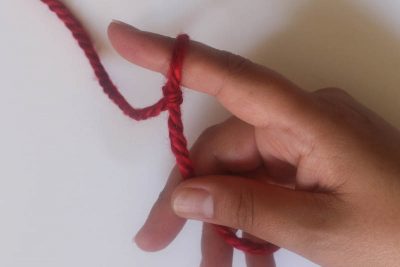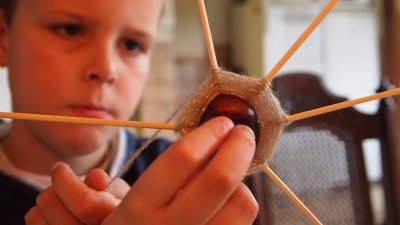If you’re a crochet lover, you know it’s a great hobby that allows you to make useful and beautiful finished objects. You may also be aware of the many other benefits crochet can provide over the course of a lifetime, including stress relief, protection from mental decline, improved motor skills, and more. The gift of crochet is one that keeps on giving, so teaching a child in your life to crochet would seem an ideal way of paying it forward.
I learned to crochet from my grandma when I was 9 and it has been a really fulfilling part of my life. Though I don’t have kids of my own, I’ve taught crochet lessons to children for several years. If you learned to crochet as an adult, or if you don’t remember your own childhood crochet experiences, it can be difficult to know where to start, so here are ten tips for teaching children to crochet.
This post contains affiliate links.
1) Use the right tools
To make things easier for you and the child you’re teaching, choose a smooth yarn in light, solid colors. Even better: Choose a yarn you’ve worked with in the past that doesn’t have the tendency to shed, split, or otherwise be difficult. Medium (worsted), light (DK), or bulky (chunky) weight yarns may be just right, depending on the size of the child’s hands. Choose a crochet hook (in a size appropriate for your yarn) with a flattened thumb rest to help the child place the hand correctly for maximum control over the hook’s movements. Plan to teach in a well lit area.
2) Break down the steps
As a seasoned crocheter, it’s easy to forget that each stitch really includes many smaller steps. When teaching crochet to a novice (whether child or adult), think about how to break down each action into multiple small steps.
As an example, a single crochet stitch includes inserting the hook into the appropriate stitch, yarning over, drawing up a loop, yarning over again, and drawing through both loops on the hook.
Feel free to let your student repeat one step over and over – like inserting the hook – until they feel comfortable.
3) Start with finger crochet
If the child you’re teaching is young or doesn’t have well developed fine motor skills, holding a hook properly can be really difficult. Finger crochet is a great alternative where you can teach the basic concepts of crochet without having to worry about holding the hook. (If you need a finger crochet refresher, here’s my tutorial along with 8 free finger crochet patterns.) Once the child is a finger crochet master, it will be much easier to add a hook into the mix!
4) Age (usually) matters
While there are some crochet prodigies who pick up hooks and finish projects at very young ages, most young children lack the fine motor skill development to crochet comfortably with a hook.
If you know a child expressing an interest in the crochet but having difficulty maneuvering the hook, consider other ways to expose them to yarn and keep them engaged until they develop the necessary dexterity. Besides finger crochet, try winding yarn into balls, playing Cat’s cradle, or wrapping yarn over popsicle sticks to make God’s Eyes. Another option is to let the child sit on your lap with your hands guiding theirs.
Choose the most developmentally appropriate activities to keep children interested in the crochet rather than frustrated with it.
5) Don’t move on too soon
While it’s tempting to teach many stitches and techniques in one sitting to an enthusiastic child, it’s best to focus on one skill at a time. This will help the child remember what they learned at the next session and will ultimately lead to greater mastery. Think about projects that can be made with each small step. For example, long chains make great necklaces, friendship bracelets, and scarves for toys. They can also be braided together to make necklaces and scarves. Single crochet pieces can be joined and stuffed to transform into balls to play with or crochet critters.
6) Take a cue from freeform crochet
Freeform crochet allows you to work intuitively with yarn without a pattern by following your instincts. Freeform provides a great format for teaching children. Allow them to finish a piece when they think it is finished, or combine multiple stitches, working in the round and working in rows, different colors, and more into one piece.
Once several pieces are completed, use felt or clothing as a background and fabric glue or sew pieces to the top as embellishment. This allows the child to explore at their own pace while still getting the sense of accomplishment from completing projects.
7) Avoid written patterns
When crocheting with kids, especially pre-teens, remember that written patterns generally include abbreviations. Learning to read these is like learning another language. Imagine learning a new language while also learning a new motor skill! (If you’re like me and can’t pat your head while rubbing your tummy, you’ll know this is a big challenge.)
Use patterns for project inspiration, but encourage children to make shapes of specific sizes rather than trying to read a pattern. As an example, to crochet a bag, make a rectangle twice as big as you want the finished bag to be, then fold it in half and seam two sides closed.
8) See the project through the child’s eyes
While adult students are often ridiculously critical of themselves, children are generally quite satisfied with “imperfect” projects. Instead of focusing on the stitch that is too big or the edge that is a bit wonky, celebrate the child’s creativity and perseverance in completing a project.
Teens tend to be more critical, so remind them that little boo boos can be fixed with blocking or by covering with a decorative button.
9) Remember that all the usual rules apply
I happen to think that crochet is the most awesome craft on earth, but when teaching children, keep in mind that attention spans are shorter, motor skills are less developed, and so on. Also, don’t forget to think about clean up before you even get started on a project! Having a plan for putting supplies away as soon as the child gets bored will make it easier to find and continue the project later.
10) Consider alternatives
If teaching crochet is making the hobby less relaxing for you, consider seeking out a group class for your child. Look for craft camps, “mommy and me” classes, or mixed-age classes through craft supply stores, libraries, and youth programs.
One final note: Special considerations for teens
Teens may have a keen interest in crocheting and generally have the motor skills and reading comprehension to move ahead on their own. Sometimes, however, they lack patience and expect perfection from themselves. When teaching teens, remember to reinforce that crochet, like all skills, improves with practice and may not be perfect the first time around.
I hope you enjoyed these tips! If you’re interested in teaching crochet (or other crafts) for side income, check out my book, Make Money Teaching Crochet: Launch Your Business, Increase Your Side Income, Reach More Students.








Wonderful information for me, my granddaughter are 9 and 8 and just started to show interest. I want them to WANT to try and to learn to love crochet as much as I do! Thank you!
My 9 year old has shown an interest in learning crochet. These tips will be very useful as I try to teach her not only to crochet but hopefully instill a love of crochet. Thanks
I do not in any way consider myself a crochet expert but have made many scarves and blankets. I teach math in a middle school and (pray for me and my students) will be teaching 25 students to crochet during lunch and homeroom. They will in turn each teach another student, and the teaching will continue. Over 60 students expressed an interest! Perfect timing for these tips. Thank you.
So glad these could help, Luli. Have fun with the group!
I learned to crochet from my mother when I was about 5 years old. I’m 75+ now. When I learned, there was not so much work done with anything by thread and small metal hooks. Lots of doily and dish cloth and pillow case trim being made. I remember it well and loved every bit of it. I wanted, badly for my granddaughters to learn but waited until they asked and showed an interest. The were young, but really wanted to learn. I remember the first ‘session’ we had, they crocheted all afternoon, not wanting to quit. I have 3 granddaughters, now are 20, 18, and 14. I taught the oldest two to crochet when they were about 7 and 5 years old because they were interested. The both do very well, one especially is still crocheting often, has made things to sell at sales at school etc. The 18 year old enjoys it, but in spells. The 14 year old has interest in animals, horses and competes in rodeo. She takes spells where she wants to get ‘into’ crochet again. I think one day, when she’s a little older and really less busy…..if that ever happens…..,she will enjoy it. At one time I thought it was going to be a lost art, but I think the use of computers have helped to bring people who are interest, together. Like this sight. Thank you for sharing your information. It is appreciated.
Marie
Hi my fellow Marie, thanks for sharing your story! I learned from my grandmother, too, and definitely had “spells” where I would put crochet down for a while. I’m also glad it isn’t a lost art!
My grandaughter is trying to learn, but has trouble with her tension, I don’t know how to get her to understand this,,
Carol, I don’t usually teach children about tension because tension becomes more regular once people have mastered the mechanics of making the stitches. If she can’t understand it, she probably lacks the skills at the moment to have an even tension.